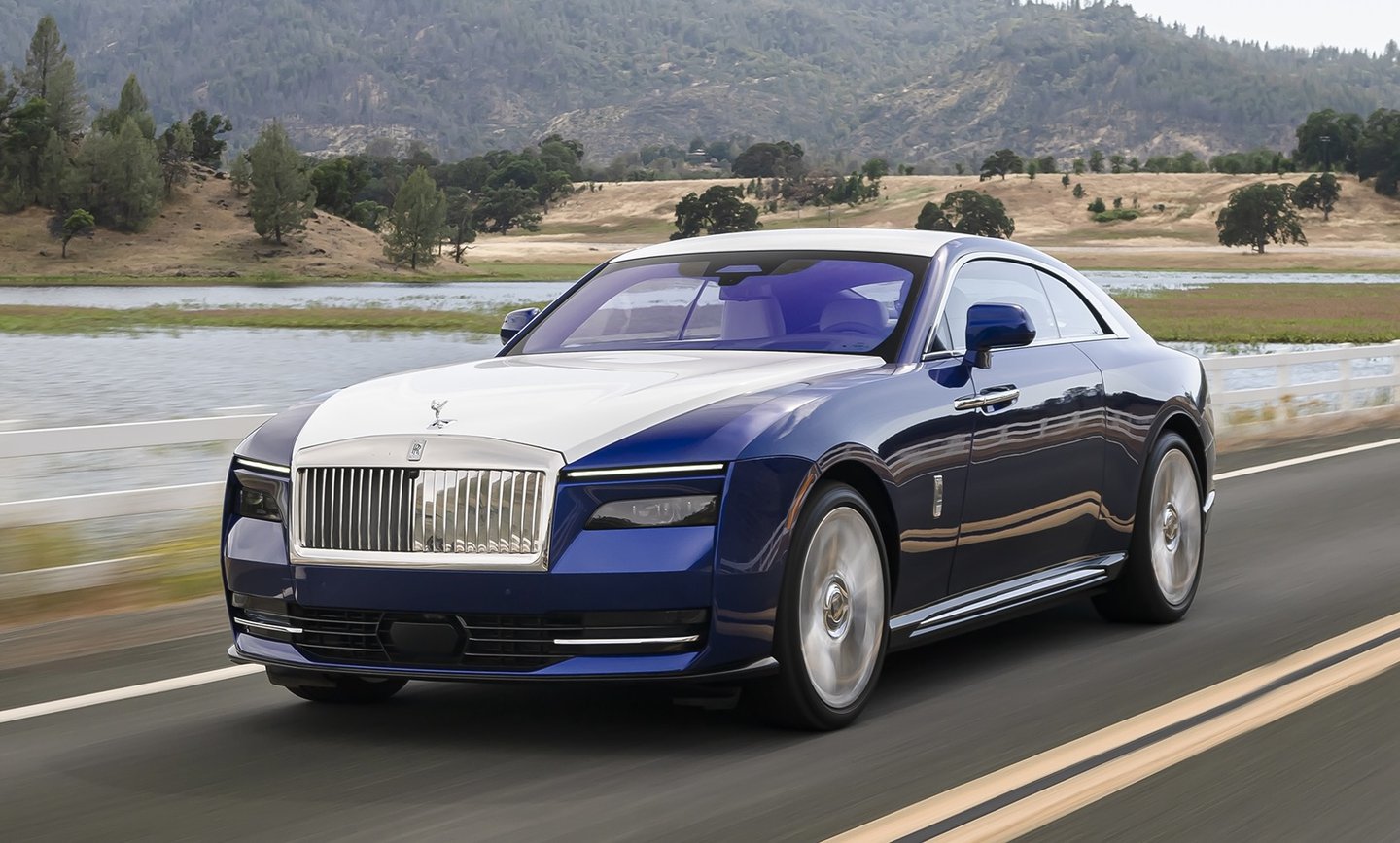
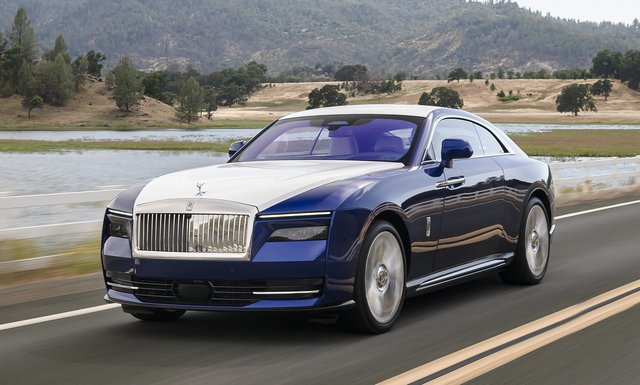
→
Scroll to discover more
The story of Rolls-Royce
The Rolls-Royce of cars
On the 4th of May, 1904, two men met at the Midland hotel in Manchester. They were strangers, but over lunch they decided to make the best motor car in the world. Which they then did. Their partnership lasted less than six years, but in that time their names became inseparable. They had created one of the world's strongest, most resilient and most respected brands. Their joint name has become a synonym for excellence: every brand in the world wants to be "The Rolls-Royce of..."
When Pentagram refreshed the identity in 2020, they described Rolls-Royce as "the most precious brand in the world".
It may well be that, but we still don't know much about the original identity. The badge, created by overlapping two caps Rs, has been on every car for 118 years, but no-one knows who designed it. Likewise, the unmistakeable "Pantheon" radiator, also on every vehicle - even carried forward onto the all-electric Spectre - is also a book without an author.
When Pentagram refreshed the identity in 2020, they described Rolls-Royce as "the most precious brand in the world".
It may well be that, but we still don't know much about the original identity. The badge, created by overlapping two caps Rs, has been on every car for 118 years, but no-one knows who designed it. Likewise, the unmistakeable "Pantheon" radiator, also on every vehicle - even carried forward onto the all-electric Spectre - is also a book without an author.
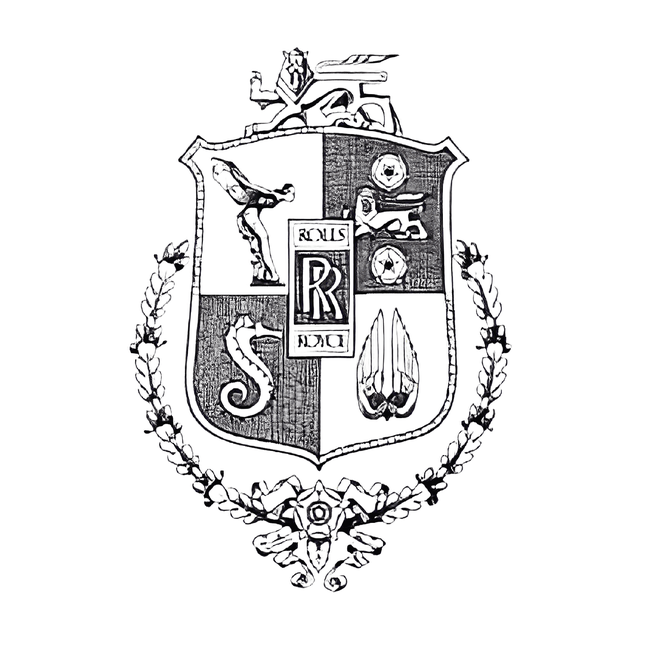
Begin as you mean to go on. The heraldic look, 1906-1934
But there are bigger problems than that: it is also a brand that polarises. Some people - and there are a lot of them - can't get past the idea of a huge, thirsty car that costs twice as much as a decent house.
And if that idea is offensive, just look at the users. We judge brands by their customers. Rolls-Royce has always targeted heads of state and leaders of industry. Over time it has attracted celebrities from the world of entertainment and sport. So it's hardly surprising that the user group can generously be described as a mixed bag. The good, the bad and the very, very ugly. Jimmy Savile was a vocal loyalist. But so were John Lennon and Paul McCartney, perhaps the only British double act to equal the eponymous Rolls and Royce. A gathering of the most famous Rolls-Royce owners would look like a recreation of the cover for their Sgt, Pepper's Lonely Hearts Club Band album. Would Vladimir Ilyich Lenin (9 cars) be comfortable sharing the stage with Elvis Aaron Presley (only 1)? Queen Elizabeth the Second with Fifty Cent? It's an eclectic group that would include dozens of Olympic medallists and more than forty Nobel Prize winners. Plus Alfred Nobel himself.
But if the image of the brand may be controversial for some, the quality of the product is beyond question. From day one, the quality control has been legendary. Here is an extraordinary fact: more than 73% of the Rolls Royce cars ever made are still roadworthy.
And the drivers are getting younger. In 2000, the average age of a Rolls Royce driver was over 60. Today it is 42. That makes the Rolls Royce the youngest car in the BMW Group. Its driver profile is younger than the Mini.
The most precious brand in the world? Yes, quite possibly.
And if that idea is offensive, just look at the users. We judge brands by their customers. Rolls-Royce has always targeted heads of state and leaders of industry. Over time it has attracted celebrities from the world of entertainment and sport. So it's hardly surprising that the user group can generously be described as a mixed bag. The good, the bad and the very, very ugly. Jimmy Savile was a vocal loyalist. But so were John Lennon and Paul McCartney, perhaps the only British double act to equal the eponymous Rolls and Royce. A gathering of the most famous Rolls-Royce owners would look like a recreation of the cover for their Sgt, Pepper's Lonely Hearts Club Band album. Would Vladimir Ilyich Lenin (9 cars) be comfortable sharing the stage with Elvis Aaron Presley (only 1)? Queen Elizabeth the Second with Fifty Cent? It's an eclectic group that would include dozens of Olympic medallists and more than forty Nobel Prize winners. Plus Alfred Nobel himself.
But if the image of the brand may be controversial for some, the quality of the product is beyond question. From day one, the quality control has been legendary. Here is an extraordinary fact: more than 73% of the Rolls Royce cars ever made are still roadworthy.
And the drivers are getting younger. In 2000, the average age of a Rolls Royce driver was over 60. Today it is 42. That makes the Rolls Royce the youngest car in the BMW Group. Its driver profile is younger than the Mini.
The most precious brand in the world? Yes, quite possibly.
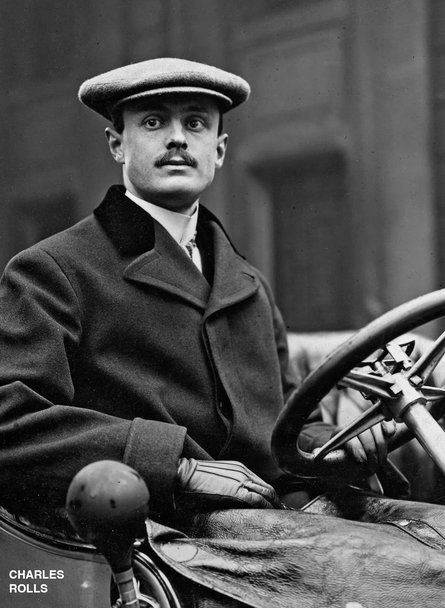
Move fast...
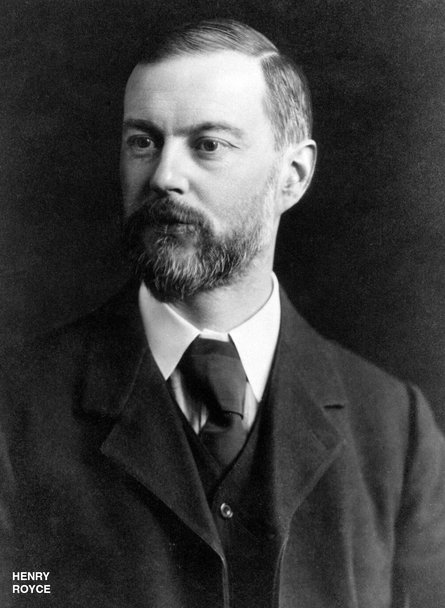
...and make things
It's an extraordinary achievement. At the start of the twentieth century, every great nation was striving to stake a claim in the new car industry: America with scale, Germany, France and Italy with quality. And yet they were all out-performed by a two-man company working from a cul-de-sac in Manchester.
So, who were Charles Rolls and Henry Royce? And how did they do it?
Charles Rolls is like a character from a Noel Coward play. Six foot five, handsome, charming and daring. Born in Berkeley Square, son of a lord. Eton - of course - then Cambridge, where he was the first student ever to frighten the horses by arriving in a rackety motor car.
He was obsessed with speed and with anything that could get him there - cars and motorcycles and aircraft and hot air balloons (he made more than two hundred flights with a group who called themselves, all too accurately, balloonatics.)
In 1900 he wrote the section on automobiles for the Encyclopedia Britannica.
In the same year he completed a thousand-mile reliability trial in a Panhard, a real feat of physical endurance in a vehicle with horse and carriage suspension on rough roads. In 1903 he set a new land speed record of 83 mph, which was witnessed but couldn't be authorised because the measuring instruments weren't of the approved type.
He was an example of the best that old money and a good background could produce: handsome, stylish and daring with old-fashioned good manners and charm. He was everything that Henry Royce wasn't.
So, who were Charles Rolls and Henry Royce? And how did they do it?
Charles Rolls is like a character from a Noel Coward play. Six foot five, handsome, charming and daring. Born in Berkeley Square, son of a lord. Eton - of course - then Cambridge, where he was the first student ever to frighten the horses by arriving in a rackety motor car.
He was obsessed with speed and with anything that could get him there - cars and motorcycles and aircraft and hot air balloons (he made more than two hundred flights with a group who called themselves, all too accurately, balloonatics.)
In 1900 he wrote the section on automobiles for the Encyclopedia Britannica.
In the same year he completed a thousand-mile reliability trial in a Panhard, a real feat of physical endurance in a vehicle with horse and carriage suspension on rough roads. In 1903 he set a new land speed record of 83 mph, which was witnessed but couldn't be authorised because the measuring instruments weren't of the approved type.
He was an example of the best that old money and a good background could produce: handsome, stylish and daring with old-fashioned good manners and charm. He was everything that Henry Royce wasn't.
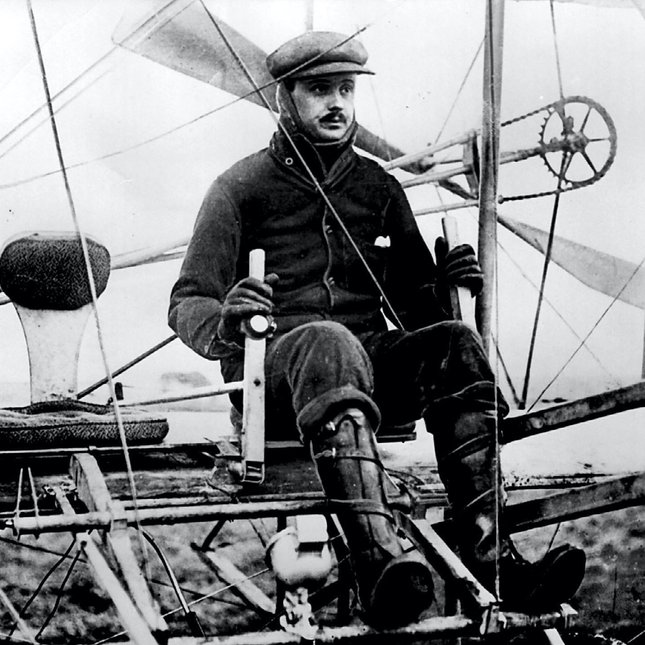
002: A licence to fly
Henry Royce was born into a baker's family in the Midlands. Baking is a low margin business that requires meticulous cash management, a skill his father did not possess. He was declared bankrupt when Henry was an infant and died in the poorhouse when the child was only eight years old.
Henry always worked to help the family out. His first job was as a bird scarer at a local farm, paid a few pennies a week. He was four years old. He left school at age of eight, having only completed one full year of schooling. The next record we have of Henry shows him delivering telegrams and post at the age of 10. Then, an aunt found him an apprenticeship, but the money ran out before he could complete it.
But by then, he had discovered what he was born to do. Engineering. Through long days at work and late nights studying, he established a company making electrical components. Over the next decade, he built himself into a prosperous and successful businessman, with clients for his new electric-powered cranes as far away as Japan. For Henry Royce engineering was not a profession, it was an obsession.
Henry always worked to help the family out. His first job was as a bird scarer at a local farm, paid a few pennies a week. He was four years old. He left school at age of eight, having only completed one full year of schooling. The next record we have of Henry shows him delivering telegrams and post at the age of 10. Then, an aunt found him an apprenticeship, but the money ran out before he could complete it.
But by then, he had discovered what he was born to do. Engineering. Through long days at work and late nights studying, he established a company making electrical components. Over the next decade, he built himself into a prosperous and successful businessman, with clients for his new electric-powered cranes as far away as Japan. For Henry Royce engineering was not a profession, it was an obsession.
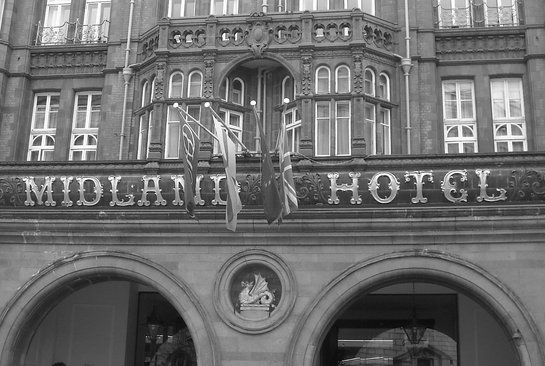
Charles Rolls, may I introduce Henry Royce?
It was this well-respected, but reserved, engineer that Charles Rolls met at the Midland Hotel. Rolls was not in the best of moods. He'd arrived at one of the most important meetings in the history of motoring by train. Then, Royce invited him for a ride in his latest project: a two cylinder vehicle. Rolls despised two cylinders. Pointless. Feeble. Noisy. Messy. A complete waste of time.
Within fifty yards, he had completely changed his mind. The car he was riding in, the Royce 10, was quieter and smoother than anything he had ever experienced. The best four cylinders, and even the big French six cylinders, could not match this effortless performance. It was a beautiful, serene, piece of engineering.
Then and there, a profound partnership was formed. Royce knew how to make cars and was on his way to becoming one of the best engineers the world had ever seen, and Rolls knew how to sell them. He personally knew just about anybody in Europe who would want to buy a very expensive, very high performance vehicle. And if he didn't know them, he would know somebody who did.
The first Rolls-Royce car, the two cylinder Rolls-Royce 10hp, was unveiled in Paris in December 1904. The three and four cylinder models followed soon afterwards.
In 1906 Rolls-Royce Ltd was registered.
Within fifty yards, he had completely changed his mind. The car he was riding in, the Royce 10, was quieter and smoother than anything he had ever experienced. The best four cylinders, and even the big French six cylinders, could not match this effortless performance. It was a beautiful, serene, piece of engineering.
Then and there, a profound partnership was formed. Royce knew how to make cars and was on his way to becoming one of the best engineers the world had ever seen, and Rolls knew how to sell them. He personally knew just about anybody in Europe who would want to buy a very expensive, very high performance vehicle. And if he didn't know them, he would know somebody who did.
The first Rolls-Royce car, the two cylinder Rolls-Royce 10hp, was unveiled in Paris in December 1904. The three and four cylinder models followed soon afterwards.
In 1906 Rolls-Royce Ltd was registered.
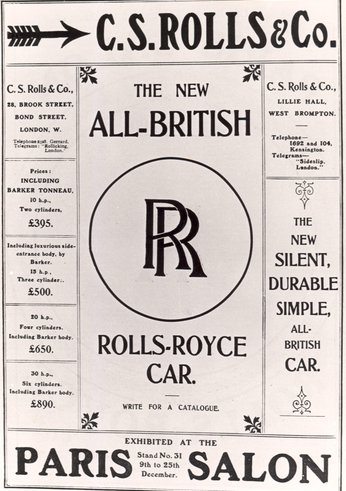
Reigning in Paris
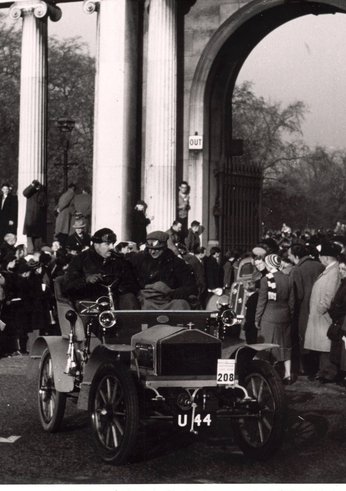
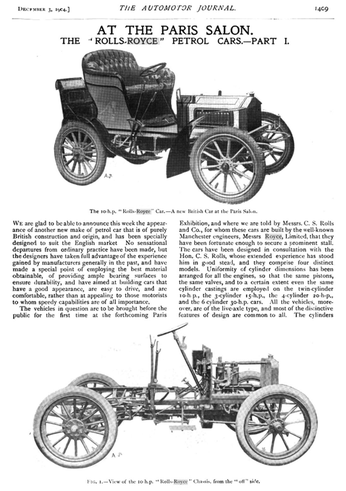
In that same year, the six cylinder Rolls-Royce was revealed. This was the one the world had been waiting for. It was smooth, silent and sophisticated. Lord Montagu, a fan from day one, would demonstrate the stability of the engine by filling a line of champagne glasses on the bonnet. Having quaffed the champagne, he would then head home. The roads were quieter then.
Claude Johnson, the MD, had an instinct for publicity that perfectly complemented Rolls' flair for showmanship. In a genius piece of instinctive marketing they made a Special Edition with all the panelling polished silver and the metallic components silver plated. It glowed and gleamed. When combined with the silky smooth and almost silent movement, the effect was ethereal.
They named the car, like a yacht, "Silver Ghost" and took it to Paris.
The sheer quality of the vehicle guaranteed that it was an immediate sensation. One journalist wrote “If a six cylinder vehicle goes past and you can't hear anything, it's a Rolls-Royce."
But another journalist was even more definitive. He wrote a six word conclusion that was to be quoted in Rolls Royce advertising for decades to come:
"The best car in the world"
Claude Johnson, the MD, had an instinct for publicity that perfectly complemented Rolls' flair for showmanship. In a genius piece of instinctive marketing they made a Special Edition with all the panelling polished silver and the metallic components silver plated. It glowed and gleamed. When combined with the silky smooth and almost silent movement, the effect was ethereal.
They named the car, like a yacht, "Silver Ghost" and took it to Paris.
The sheer quality of the vehicle guaranteed that it was an immediate sensation. One journalist wrote “If a six cylinder vehicle goes past and you can't hear anything, it's a Rolls-Royce."
But another journalist was even more definitive. He wrote a six word conclusion that was to be quoted in Rolls Royce advertising for decades to come:
"The best car in the world"
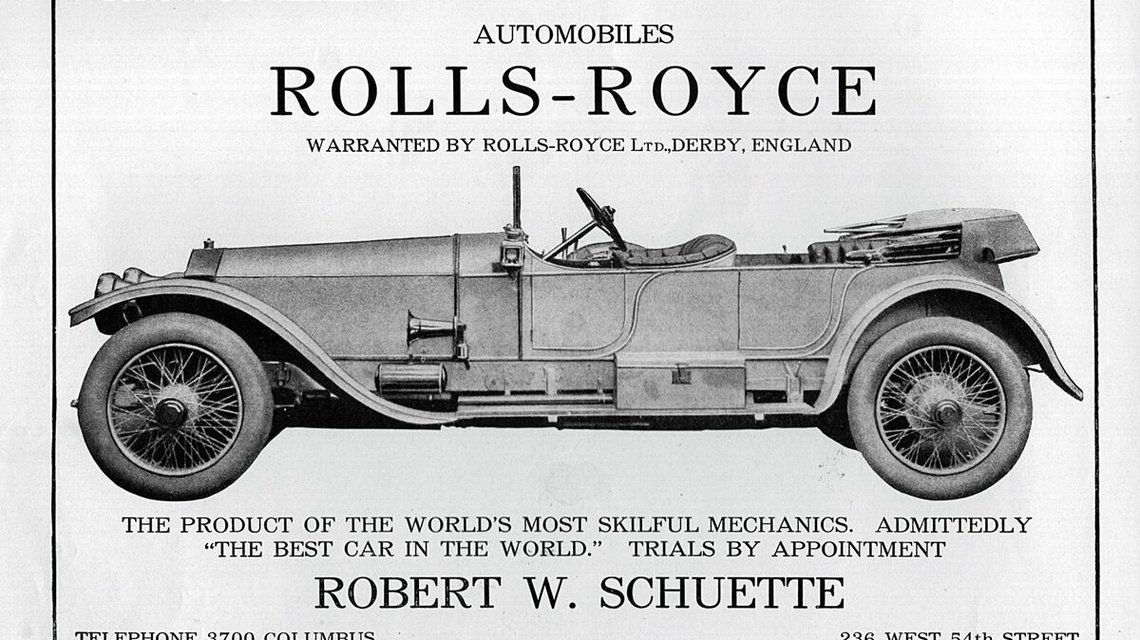
"Admittedly"
There were few who would disagree. Within weeks, the Silver Ghost was the benchmark against which every other vehicle was measured.
1906 was a busy year for Charles Rolls. In May, he broke the Monte Carlo to London record in a Ghost. In October, he was in New York to demonstrate its speed on the Empire City track. His more efficient engine slipped gracefully past all the bigger, noisier, local contenders. In one visit, Rolls-Royce had conquered America.
Henry Ford, not known for his generosity to his competitors, said Royce was the only person in the world who could put heart into an automobile. He bought a Silver Ghost, the only car he ever owned that was made by another manufacturer.
What set Rolls-Royce cars apart was not just that they were smooth, silent and beautiful, but that they had achieved the impossible: they were reliable.
In 1907 the Ghost was entered for the brutal Scottish Reliability Trials, a 750-mile 4-day test on seasonal roads in the worst of weathers. It was a test best suited to tough, rugged agricultural vehicles. The urbane Ghost took the gold.
The next challenge, in the same year, was the record for non-stop motoring which stood at 7098 miles. Under RAC supervision, the Ghost clocked up an astonishing 15,000 miles.
1906 was a busy year for Charles Rolls. In May, he broke the Monte Carlo to London record in a Ghost. In October, he was in New York to demonstrate its speed on the Empire City track. His more efficient engine slipped gracefully past all the bigger, noisier, local contenders. In one visit, Rolls-Royce had conquered America.
Henry Ford, not known for his generosity to his competitors, said Royce was the only person in the world who could put heart into an automobile. He bought a Silver Ghost, the only car he ever owned that was made by another manufacturer.
What set Rolls-Royce cars apart was not just that they were smooth, silent and beautiful, but that they had achieved the impossible: they were reliable.
In 1907 the Ghost was entered for the brutal Scottish Reliability Trials, a 750-mile 4-day test on seasonal roads in the worst of weathers. It was a test best suited to tough, rugged agricultural vehicles. The urbane Ghost took the gold.
The next challenge, in the same year, was the record for non-stop motoring which stood at 7098 miles. Under RAC supervision, the Ghost clocked up an astonishing 15,000 miles.
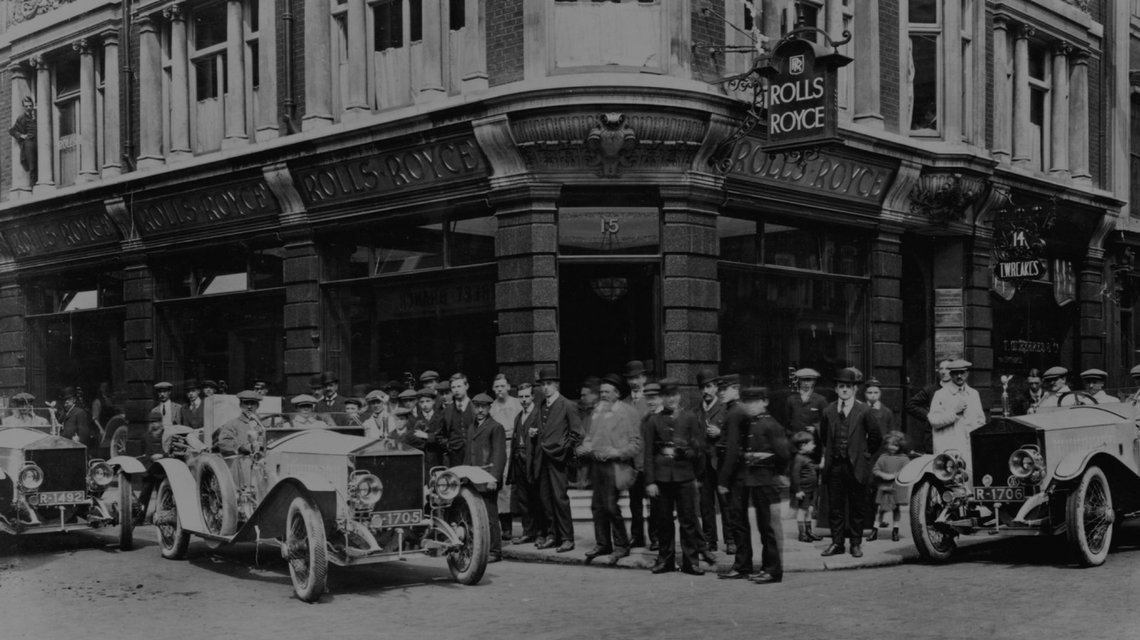
Mayfair, of course
At Rolls-Royce a radical decision was made. They would become a single product company. They would focus on making Ghosts and discontinue all the other - popular - models. And every car would be bespoke, designed to an individual customer's requirements. Like a Savile Row suit or a wedding dress.
This flew in the face of everything that the world was learning about the fashionable new science of mass production. But Rolls-Royce wanted to produce perfection, and there is only one way to do perfection and that is to do it all the way. They could see the future, and they chose to face another direction.
Their audience went with them. To this day, every Rolls-Royce is still made to order.
This flew in the face of everything that the world was learning about the fashionable new science of mass production. But Rolls-Royce wanted to produce perfection, and there is only one way to do perfection and that is to do it all the way. They could see the future, and they chose to face another direction.
Their audience went with them. To this day, every Rolls-Royce is still made to order.
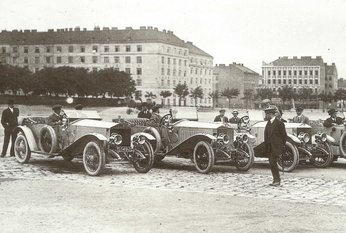
Alpine Tourer
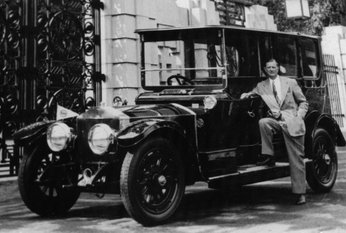
Landaulette
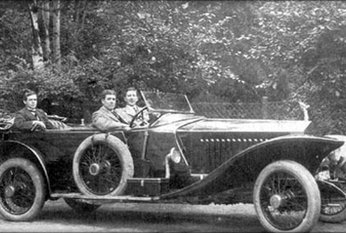
Skiff
There was no market research behind this decision. Customer focus groups hadn't yet been invented but the idea of trying to convene such a thing for potential Rolls Royce owners was laughable. Anyway, Charles Rolls knew most of the customers and understood all too well that there are people in this world, himself amongst them, who insist on the very finest and who don't care what it costs.
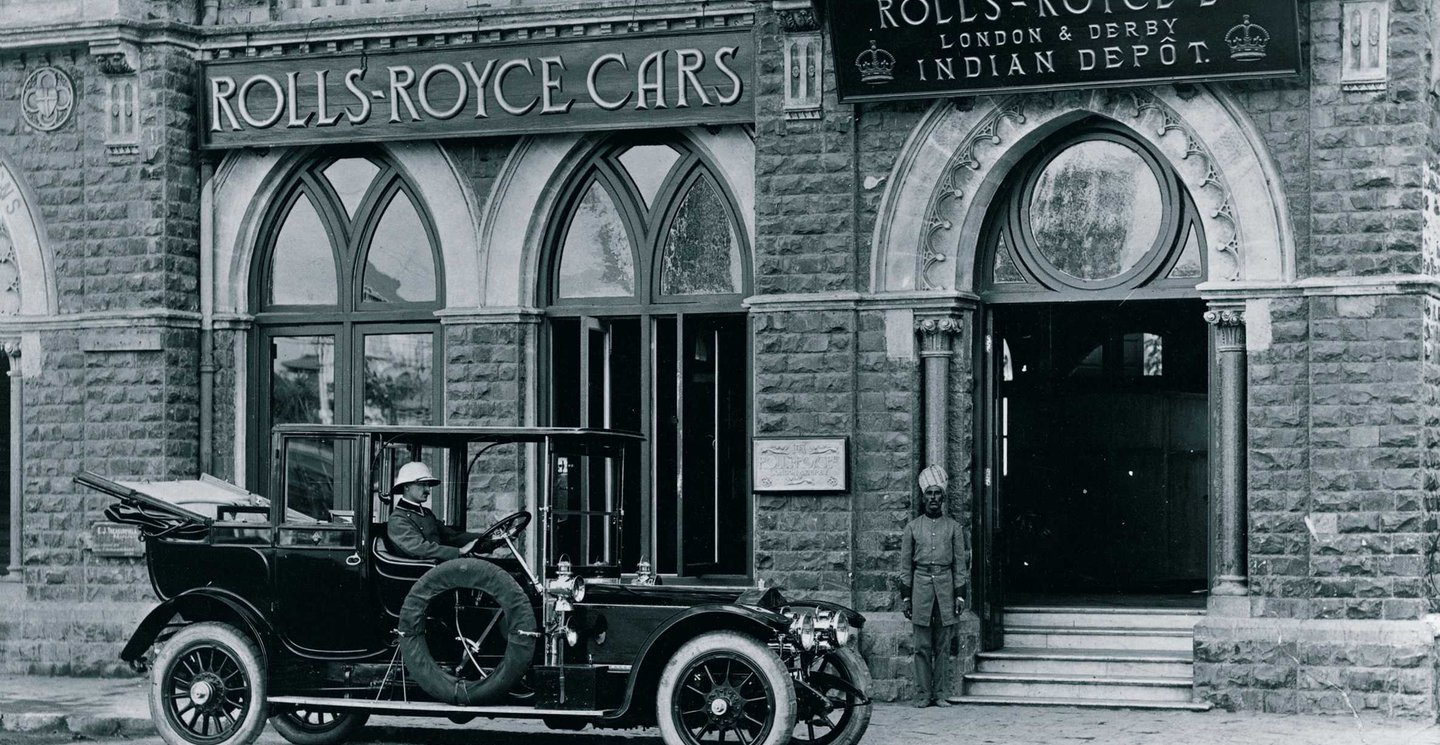
The brand enjoyed mystical status amongst Maharajahs and Maharishis
The name was decided. The badge also.
A mascot for the bonnet. The very expression would make Henry Royce shudder. He was infuriated when the humble but practical radiator cap started to be used as a platform for flags, shields, bears, unicorns and all kinds of faux heraldic nonsense.
But Charles Rolls saw an opportunity.
The emblem. The "Spirit of Ecstasy" was designed in 1909 by Charles Sykes. The model was for many years a much-denied mystery, but it's now acknowledged that it was Eleanor Velasco Thornton, a free spirited young woman who was rather more than Lord Montagu's personal assistant. Her short but dramatic life ended in 1915 when the SS Persia was torpedoed by U-boat off Crete, where she was travelling with the aforementioned Lord M.
Since then, she has sailed ahead of every Rolls-Royce car ever made. It was rumoured that she was pure silver, which was never true, although she has made an occasional, overseas, appearance in solid gold.
A mascot for the bonnet. The very expression would make Henry Royce shudder. He was infuriated when the humble but practical radiator cap started to be used as a platform for flags, shields, bears, unicorns and all kinds of faux heraldic nonsense.
But Charles Rolls saw an opportunity.
The emblem. The "Spirit of Ecstasy" was designed in 1909 by Charles Sykes. The model was for many years a much-denied mystery, but it's now acknowledged that it was Eleanor Velasco Thornton, a free spirited young woman who was rather more than Lord Montagu's personal assistant. Her short but dramatic life ended in 1915 when the SS Persia was torpedoed by U-boat off Crete, where she was travelling with the aforementioned Lord M.
Since then, she has sailed ahead of every Rolls-Royce car ever made. It was rumoured that she was pure silver, which was never true, although she has made an occasional, overseas, appearance in solid gold.
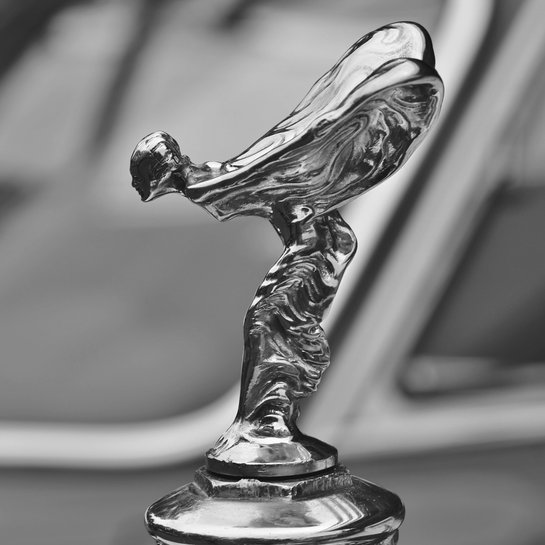
The Spirit of Ecstasy was thought to be too revealing...
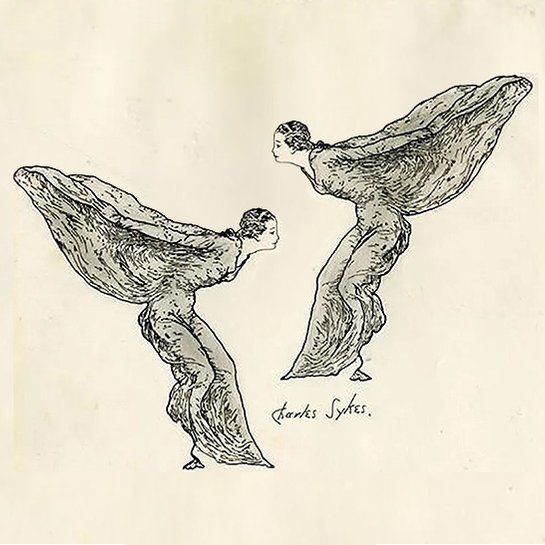
but she concealed a secret
Rolls-Royces have always been luxury cars that drive like sports cars. Rolls, of course, loved racing, but Royce thought it was a feeble activity "for people with something to prove." He believed that the right place to test a car was on the road, not the track. So, instead, they issued an open challenge, with a £1000 wager (about £150,000 today) for any competitor to meet a Silver Ghost in a 15,000-mile road test to include a 200-mile race on the track at Brooklands. They got no takers.
In the record books, at various times Rolls Royce engines have held world speed records on land, on sea and in the air. Sometimes all at once. In the 1930s the fearless figure of Malcolm Campbell led the world with a string of land and sea records in his streamlined vehicles and vessels, all called Blue Bird and all powered by Rolls-Royce. On water and on land, there would always be a white silk scarf flashing in the slipstream.
In the record books, at various times Rolls Royce engines have held world speed records on land, on sea and in the air. Sometimes all at once. In the 1930s the fearless figure of Malcolm Campbell led the world with a string of land and sea records in his streamlined vehicles and vessels, all called Blue Bird and all powered by Rolls-Royce. On water and on land, there would always be a white silk scarf flashing in the slipstream.
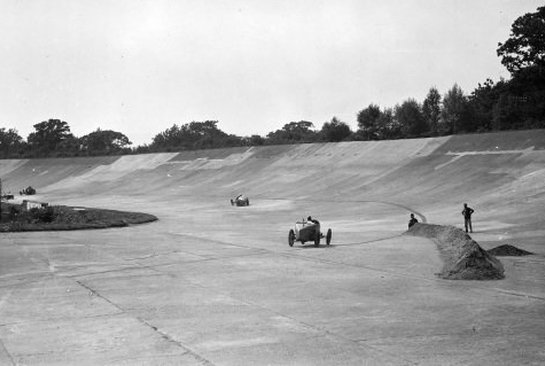
No hiding place. The track at Brooklands
It's fair to say that Rolls-Royce advertising hasn't always reached the standards of the cars, but in there is one famous occasion when it did.
'At 60 miles an hour the loudest noise in this new Rolls Royce comes from the electric clock.'
A classic ad for a classic car. One of the most famous of all time, written by David Ogilvy himself. Great copywriters write great lines. Or, sometimes, they find them. As was the case here, where the writer is quoting from an article in Motor magazine.
'At 60 miles an hour the loudest noise in this new Rolls Royce comes from the electric clock.'
A classic ad for a classic car. One of the most famous of all time, written by David Ogilvy himself. Great copywriters write great lines. Or, sometimes, they find them. As was the case here, where the writer is quoting from an article in Motor magazine.
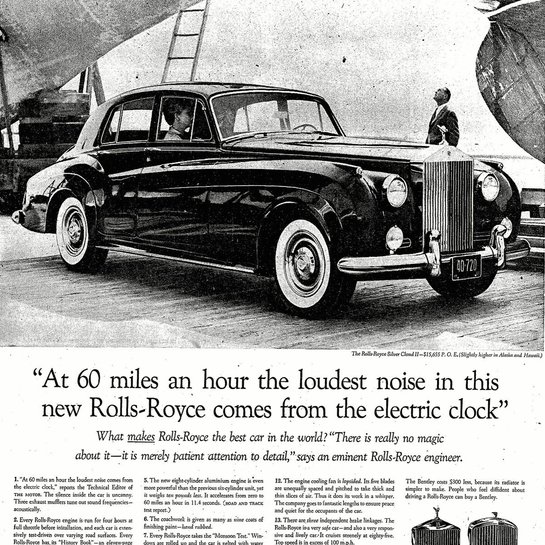
Silence is golden
The names Rolls and Royce are inevitably linked, like Lennon and McCartney. But, like The Beatles, the partnership only lasted a few short years, although its impact would echo across the world and shows no sign of fading.
By 1908 Rolls-Royce was already a highly respected brand. But Charles Rolls burnt through passions as quickly as he wore out tyres. There was always a New Big Thing. And now that thing was...flying.
Being the man he was, he didn't do things by half measures. The natural thing to do was to go to America and meet the Wright brothers. On the 8th of October 1908 he took his first flight, accompanied by Wilbur Wright, not far from Le Mans.
From then on, flying consumed him. The second pilot's licence issued in Britain was to Charles Rolls, and he became the first flier ever to make a non-stop return crossing of the English Channel.
He was one of the first to buy a Wright Flyer. Demonstrating this aircraft at Bournemouth, on July 12, 1910, Charles Rolls crashed and died. He was 32 years old.
And so one the great partnerships in business history was over before, you might think, it really got started.
But Rolls had created a strong and stable company with a good and fully engaged board. And he had never been involved in the design and production of the vehicles, that had all been Royce.
In the few short years of the partnership, a brand positioning had been sketched and filled in: Rolls-Royce stood for luxurious excellence, without compromise. If they could sustain that, then it might be possible for the new company to survive the loss of its charismatic founder.
It was all down to the quiet man, Henry Royce.
By 1908 Rolls-Royce was already a highly respected brand. But Charles Rolls burnt through passions as quickly as he wore out tyres. There was always a New Big Thing. And now that thing was...flying.
Being the man he was, he didn't do things by half measures. The natural thing to do was to go to America and meet the Wright brothers. On the 8th of October 1908 he took his first flight, accompanied by Wilbur Wright, not far from Le Mans.
From then on, flying consumed him. The second pilot's licence issued in Britain was to Charles Rolls, and he became the first flier ever to make a non-stop return crossing of the English Channel.
He was one of the first to buy a Wright Flyer. Demonstrating this aircraft at Bournemouth, on July 12, 1910, Charles Rolls crashed and died. He was 32 years old.
And so one the great partnerships in business history was over before, you might think, it really got started.
But Rolls had created a strong and stable company with a good and fully engaged board. And he had never been involved in the design and production of the vehicles, that had all been Royce.
In the few short years of the partnership, a brand positioning had been sketched and filled in: Rolls-Royce stood for luxurious excellence, without compromise. If they could sustain that, then it might be possible for the new company to survive the loss of its charismatic founder.
It was all down to the quiet man, Henry Royce.
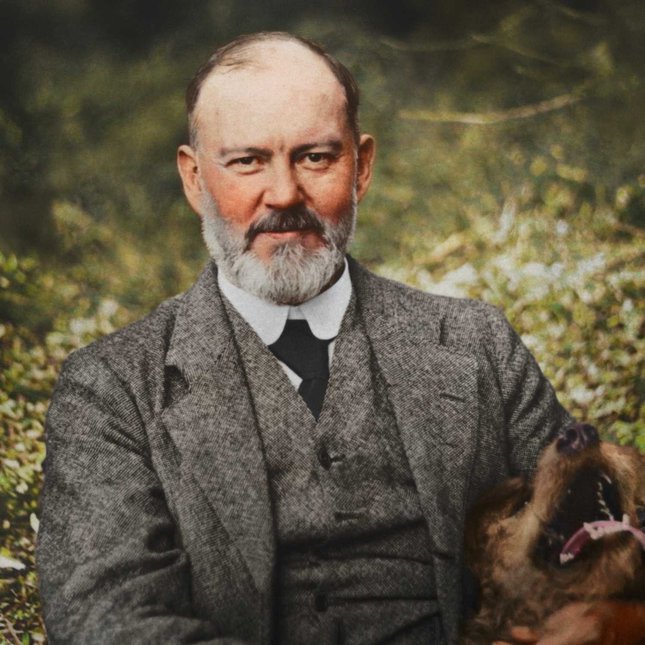
"Find perfection. Then improve on it."
He was always known as R at the factory. Even after he was elevated to the House of Lords, he still signed his name, H Royce, Mechanic. That was the title he valued most.
He never had an office, but, as Enzo Ferrari would decades later, kept a table and a chair in the corner of the workshop where he pored over drawings, completely oblivious to the clamour and din going on around him.
His work ethic was relentless. It wasn't uncommon for him to work all day, then through the night, then all the next day.
Some days he'd arrive, walk straight across the workshop and slide in under a vehicle to start making adjustments, still in his overcoat. His foreman would collect his overalls and wait patiently until he reappeared.
One morning he saw an apprentice setting out the tools to file a hex nut precisely. Royce picked up the file and did it himself, by eye and without any instruments. When he was finished the micrometre showed that the six sides were all precisely the same length. The boy kept that nut in the pocket of his overalls for 48 years. When he retired, he added it to his watch chain.
Royce often forgot to eat, which took a toll on his health later in life. His assistant would leave him a glass of milk at 10 in the morning. It would still be there, untouched, at 8:00 in the evening.
He even had an engineer's system for interviewing cooks for his home. He asked them to boil a pot of potatoes. If they boiled them all at once that was no good. If they separated them to large and small and added them to the water sequentially, to show an understanding that large take longer to cook than small, they got the job.
He never had an office, but, as Enzo Ferrari would decades later, kept a table and a chair in the corner of the workshop where he pored over drawings, completely oblivious to the clamour and din going on around him.
His work ethic was relentless. It wasn't uncommon for him to work all day, then through the night, then all the next day.
Some days he'd arrive, walk straight across the workshop and slide in under a vehicle to start making adjustments, still in his overcoat. His foreman would collect his overalls and wait patiently until he reappeared.
One morning he saw an apprentice setting out the tools to file a hex nut precisely. Royce picked up the file and did it himself, by eye and without any instruments. When he was finished the micrometre showed that the six sides were all precisely the same length. The boy kept that nut in the pocket of his overalls for 48 years. When he retired, he added it to his watch chain.
Royce often forgot to eat, which took a toll on his health later in life. His assistant would leave him a glass of milk at 10 in the morning. It would still be there, untouched, at 8:00 in the evening.
He even had an engineer's system for interviewing cooks for his home. He asked them to boil a pot of potatoes. If they boiled them all at once that was no good. If they separated them to large and small and added them to the water sequentially, to show an understanding that large take longer to cook than small, they got the job.
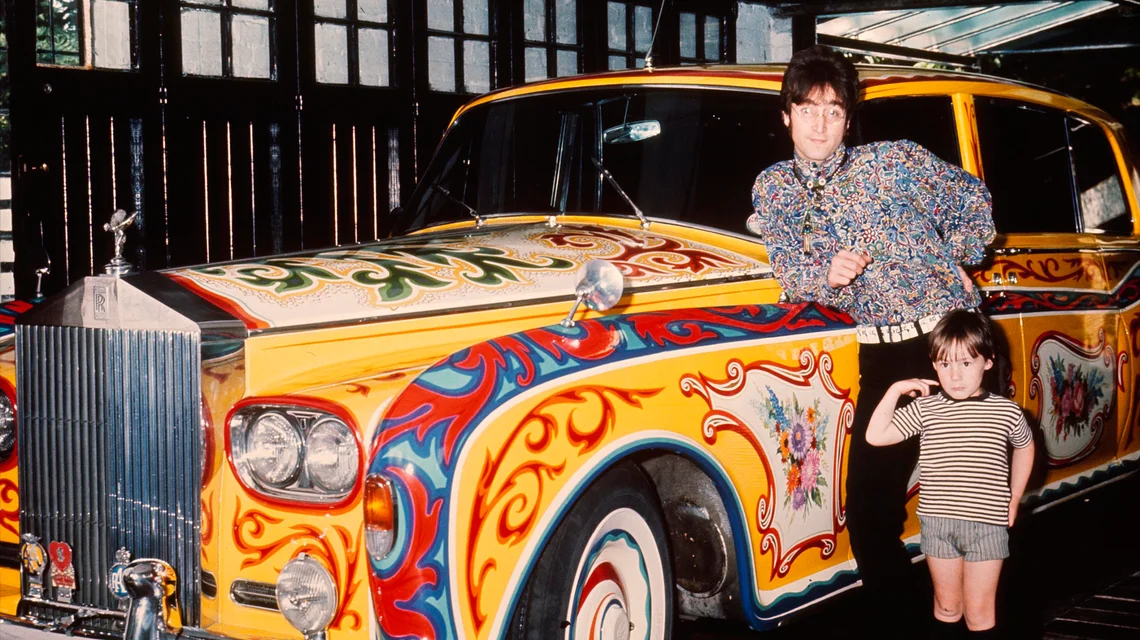
Baby, you can drive my car
Charles Rolls left a legacy of an order book filled with Ghosts. True to his own mantra, Royce began to look for way to improve this, seemingly perfect, machine. The Ghost was in full production for twenty years, when it was replaced by the first series of Phantoms. Then on through the long list of Shadows, Wraiths, Dawns, Spectres.
They don't look like other cars and they don't behave like other cars. The interior of most cars try to hint at Formula One, all sporty and racy. A classic Rolls Royce looks like an elegant drawing room. It has Wilton carpets, mahogany panelling and, if you're lucky, crystal decanters on a silver tray. It ignores the road. You don't hear it and you don't feel it, so you can just pretend it's not there. Extraordinary levels of soundproofing are one of the reasons that musicians choose these cars.
Then there are the details. Hundreds. Too many to mention, but here are a couple.
On a Rolls-Royce the hubcaps contra-rotate, so that the logo is always vertical.
Every Rolls-Royce is fitted with two secret umbrellas. They fit into slots in the front wings and will be revealed when the doors are open.
They don't look like other cars and they don't behave like other cars. The interior of most cars try to hint at Formula One, all sporty and racy. A classic Rolls Royce looks like an elegant drawing room. It has Wilton carpets, mahogany panelling and, if you're lucky, crystal decanters on a silver tray. It ignores the road. You don't hear it and you don't feel it, so you can just pretend it's not there. Extraordinary levels of soundproofing are one of the reasons that musicians choose these cars.
Then there are the details. Hundreds. Too many to mention, but here are a couple.
On a Rolls-Royce the hubcaps contra-rotate, so that the logo is always vertical.
Every Rolls-Royce is fitted with two secret umbrellas. They fit into slots in the front wings and will be revealed when the doors are open.
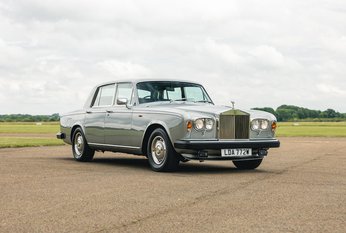
It's a Shadow
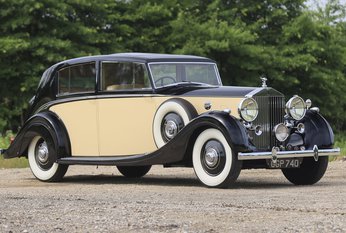
It's a Wraith
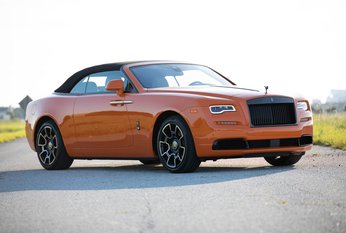
It's a new Dawn, it's a new day
When the British government belatedly realised that they needed aircraft that could match those being produced in Germany, Royce was the first choice to design the engines. These flying engines would have to be the most reliable ever made. And nobody did reliable better than Royce.
Royce had no interest in flying. Although he went on to design the most famous aero engine in the world, he never flew in an aircraft.
But he made history with the Merlin.
The Merlin engine became famous in the Spitfire. It was a complete masterpiece. Designed to be easy to manufacture and assemble, it could be mass produced: more than 200,000 were built in less than five years. As Terence Conran famously said, "If you can't tell me how to make it, then you can't say you've designed it." Henry Royce knew how to make it.
The Merlin became famous in Spitfires, but it also powered Hurricanes, Mosquitoes, and the legendary Lancaster and Wellington bombers. Perhaps most impressive of all, the Americans chose Merlins for their Mustang fighters. A Senator who wondered why the engines weren't American was smacked down with a two line telegram: "Our boys are putting their lives on the line. They deserve the best."
But designing Spitfire was a race against time. Henry Royce was partnered with the great Reginald Mitchell. Together they had won the Schneider Trophy in the most elegant race ever, a competition for single seater seaplanes. Now they were racing to re-arm Britain against the imminent threat from Germany. But they both faced greater enemies. Mitchell was told that his cancer had moved into the terminal stages and Royce knew that his fragile health was failing fast. Royce died in 1933, Mitchell in '37. They never saw their miracle fly.
All through the '30s, the team worked flat out to build the radical new fighter. Early one morning they were finishing an all-night session in the library of Sir Robert McLean, Chairman of Vickers. His daughter, famously a blithe spirit, came sauntering in after an all-night party. Still in her ball gown, with her shoes in one hand, she admired the drawings on the table.
"Wow. That is a beautiful 'plane. What's it called?"
"K5054"
She laughed at the serious grey men.
"That's not a name! Why don't you call it what my friends call me..."
Then, over her shoulder as she ran up the stairs,
"Spitfire."
Royce had no interest in flying. Although he went on to design the most famous aero engine in the world, he never flew in an aircraft.
But he made history with the Merlin.
The Merlin engine became famous in the Spitfire. It was a complete masterpiece. Designed to be easy to manufacture and assemble, it could be mass produced: more than 200,000 were built in less than five years. As Terence Conran famously said, "If you can't tell me how to make it, then you can't say you've designed it." Henry Royce knew how to make it.
The Merlin became famous in Spitfires, but it also powered Hurricanes, Mosquitoes, and the legendary Lancaster and Wellington bombers. Perhaps most impressive of all, the Americans chose Merlins for their Mustang fighters. A Senator who wondered why the engines weren't American was smacked down with a two line telegram: "Our boys are putting their lives on the line. They deserve the best."
But designing Spitfire was a race against time. Henry Royce was partnered with the great Reginald Mitchell. Together they had won the Schneider Trophy in the most elegant race ever, a competition for single seater seaplanes. Now they were racing to re-arm Britain against the imminent threat from Germany. But they both faced greater enemies. Mitchell was told that his cancer had moved into the terminal stages and Royce knew that his fragile health was failing fast. Royce died in 1933, Mitchell in '37. They never saw their miracle fly.
All through the '30s, the team worked flat out to build the radical new fighter. Early one morning they were finishing an all-night session in the library of Sir Robert McLean, Chairman of Vickers. His daughter, famously a blithe spirit, came sauntering in after an all-night party. Still in her ball gown, with her shoes in one hand, she admired the drawings on the table.
"Wow. That is a beautiful 'plane. What's it called?"
"K5054"
She laughed at the serious grey men.
"That's not a name! Why don't you call it what my friends call me..."
Then, over her shoulder as she ran up the stairs,
"Spitfire."

People in Kent recognised the roar of a Merlin engine. When they heard it they would wave to the sky.
Today, Rolls Royce is one of the finest aero engineering companies in the world. Rolls Royce aviation is a history in itself, from Spitfire to Concorde and beyond.
The 20th century saw more change than any that had gone before. The car industry was invented and raced to conquer the world. But Rolls-Royce never galloped with the herd, they moved at their own stately pace. Across that tumultuous century they released only 10 models. Ghost was followed by Phantom, Wraith, Dawn, Cloud, Shadow, Spur, Spirit, Camargue and Corniche. There were variants and every model was subject to continuous improvement, but there were only 10.
Then, in 1999, came the most challenging change of all. Rolls-Royce was bought by BMW.
The motoring press were, as they usually are, outraged and aghast. How was this possible? How could the quintessential English brand credibly survive being owned by, of all people, a German competitor? Outrageous. And whatever you do, don't mention the Merlins.
BMW understood exactly what they were buying. Rolls Royce stayed in England. Goodwood, to be precise. They imported BMW's world-leading technology to complement the Rolls Royce tradition of craftsmanship and engineering. When the product coming out of Goodwood showed no signs of faltering, and even improved, the customers stayed loyal. You don't have to explain the advantages of overseas ownership to the Rolls-Royce clientele.
The 20th century saw more change than any that had gone before. The car industry was invented and raced to conquer the world. But Rolls-Royce never galloped with the herd, they moved at their own stately pace. Across that tumultuous century they released only 10 models. Ghost was followed by Phantom, Wraith, Dawn, Cloud, Shadow, Spur, Spirit, Camargue and Corniche. There were variants and every model was subject to continuous improvement, but there were only 10.
Then, in 1999, came the most challenging change of all. Rolls-Royce was bought by BMW.
The motoring press were, as they usually are, outraged and aghast. How was this possible? How could the quintessential English brand credibly survive being owned by, of all people, a German competitor? Outrageous. And whatever you do, don't mention the Merlins.
BMW understood exactly what they were buying. Rolls Royce stayed in England. Goodwood, to be precise. They imported BMW's world-leading technology to complement the Rolls Royce tradition of craftsmanship and engineering. When the product coming out of Goodwood showed no signs of faltering, and even improved, the customers stayed loyal. You don't have to explain the advantages of overseas ownership to the Rolls-Royce clientele.
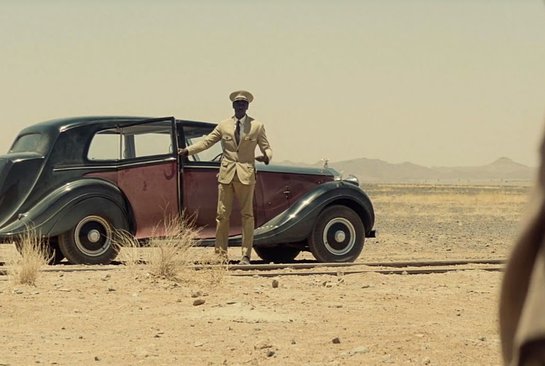
Special guest star in a dozen Bond films

The man with the Midas touch had a Phantom
2018. A brand new kind of car - the Cullinan. An SUV with all the opulent luxury you'd expect from a Rolls-Royce. If the car raised eyebrows, some of the options did too. As an alternative to the traditional Connelly leather, they offered, as a nod to the times, fabric made from bamboo. This sustainable upholstery would be secured with 2.2 million stitches taking more than 11 miles of organic thread. It may be plant-based, but it's still a Rolls-Royce.
2023. The Spectre slips silently into view. An all-electric Rolls-Royce. Truly regal in scale - eighteen feet and three tonnes - it reaches 60 in 4.5 seconds and handles like a sports car. Feedback to a dealer in California: "It can turn on a dime. Whatever that is."
The interior is so secluded that engineers had to allow faint hints of road noise because the landscape flashing by in total silence was thought to be eerie. One reviewer updated the hundred year-old slogan. "The best electric car in the world."
For most of us, the name Rolls-Royce evokes an elegant, and slightly mysterious, vehicle, gliding smoothly and silently towards a red carpet. Dark glass is a feature because it's always tempting to see who's inside. Special cars for special people. Well, interesting people, at least.
2023. The Spectre slips silently into view. An all-electric Rolls-Royce. Truly regal in scale - eighteen feet and three tonnes - it reaches 60 in 4.5 seconds and handles like a sports car. Feedback to a dealer in California: "It can turn on a dime. Whatever that is."
The interior is so secluded that engineers had to allow faint hints of road noise because the landscape flashing by in total silence was thought to be eerie. One reviewer updated the hundred year-old slogan. "The best electric car in the world."
For most of us, the name Rolls-Royce evokes an elegant, and slightly mysterious, vehicle, gliding smoothly and silently towards a red carpet. Dark glass is a feature because it's always tempting to see who's inside. Special cars for special people. Well, interesting people, at least.
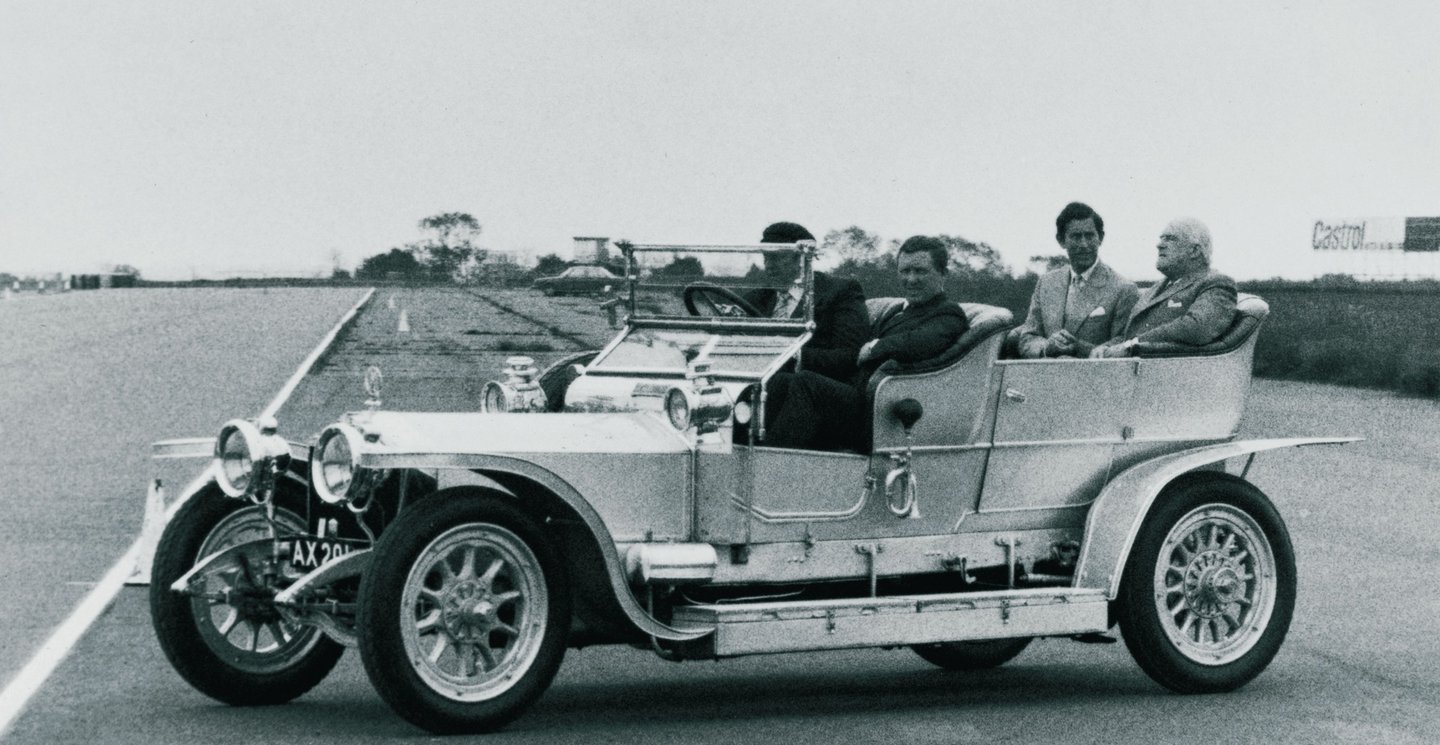
A car fit for a king
But few are quite as interesting as the odd couple who set it all in motion.
Charles Rolls and Henry Royce had almost nothing in common. They never worked in the same town and you could count on one hand the years of their partnership. But now, and forever, their names are inseparable. They have become one word.
And if a brand custodian, anywhere in the world, is looking for a word to describe uncompromising quality and unquestionable excellence, that is the word they will reach for.
And everyone, everywhere, will know exactly what it means.
Charles Rolls and Henry Royce had almost nothing in common. They never worked in the same town and you could count on one hand the years of their partnership. But now, and forever, their names are inseparable. They have become one word.
And if a brand custodian, anywhere in the world, is looking for a word to describe uncompromising quality and unquestionable excellence, that is the word they will reach for.
And everyone, everywhere, will know exactly what it means.
Featured stories
See all of our stories 